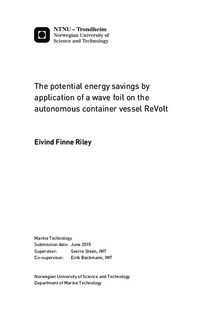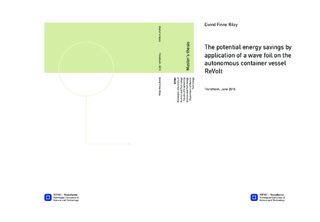| dc.description.abstract | ReVolt is an electrically propelled, autonomous concept container ship designed by DNV GL to minimize the energy consumption and cost; however, the added resistance in waves is a large resistance contributor. Effectively, this means that the battery packs of ReVolt have to be dimensioned sufficiently large to be able to complete its route legs in the worst sea states ReVolt might encounter. Batteries of today associated with a high cost.
The main focus in this thesis is assessing the benefits in terms of capital expenses (CAPEX) for ReVolt achievable by fitting so-called wave foils at the bow of the vessel. Continuous operational expenses (OPEX) is also assessed to a lesser extent.
A considerable amount of previous work has been done on the topic of wave foils in the past by other authors, and an overview of previous theoretical work and model- and full scale trials is presented. As far as known by the author, this is the first time wave foils have been tried as a CAPEX savings device in relation to electrical, sea going vessels earlier work on fuel savings have been performed more in relation to general OPEX savings.
To examine the foil performance in irregular sea, a large amount of irregular sea states are simulated, and the time averaged foil performance is found through a frequency-domain analysis. Linear foil theory is applied; however, a stalling model is implemented to model the potentially important stalling effects on the foil, which is not included in regular foil theory. The model also includes the effect of unsteady lift on an oscillating foil, and additional resistance components imposed by the foil system.
The thrust production and motion dampening effect reduces the total ship resistance in sea states applicable for wave foils. Further, the needed brake power in the examined sea states is calculated. The brake power is then converted to total energy consumption by defining a dimensioning sailing distance. This is then used to find the largest total energy consumption for ReVolt, which is what we define as the worst case scenario (WCS) for a ReVolt with and without wave foils equipped.
An overview of foil various foil mechanisms is given, with focus on the retractability of the foils. Foil size and submergence level is also looked at. Both passive foils, mounted in a fixed position, and pitching foils, able to rotate around their spanwise axis, are modelled.
The sailing conditions for ReVolt are examined by looking at scatter diagrams for the route of ReVolt. A scope of applicable sea states (made up by the parameters H_s and T_P) is defined. Within this scope applicable ranges of ship speed and wave heading angles are also defined. Wind resistance is also assessed. We seek to give an overview of the working range of the wave foils for ReVolt, and compare passive foils to pitching foils to assess what sea states are optimal for each foil configuration.
The foils are observed to yield benefits in terms of energy consumption reduction for a large amount of scenarios defined by the outlined scope. The largest thrust production is found at sea states with longer peak wave periods than the peak period giving the largest added resistance, but the foils still seem effective at reducing the energy consumption in the worst case scenarios.
At Revolt s design speed of six knots, our results imply a reduction of dimensioning battery size by 16.6%, or 1.27MWh, associated with a CAPEX reduction of 1.27MUSD, or 10.1MNOK.
At lower vessel speeds, the foil performance decreases, and within our range of speeds examined, the foil performance increases with increasing vessel speed. A result of this is that at the worst case scenario, the dimensioning battery size has been shown to be only slightly higher for a ReVolt completing a worst case scenario route leg at eight knots, when compared to the energy needed to complete a WCS route leg at four knots. Thus, reducing the speed to overcome the WCS might not be the best option for ReVolt equipped with wave foils. Rather, with the benefits of a much shorter sailing time for a route leg also taken into consideration, increasing the ship speed to overcome a WCS is thought to be a good option.
OPEX savings are discussed, and potential OPEX benefits are found in a large amount of the sea states considered. As ReVolt does not consume a large amount of energy, the OPEX savings are not very large but accumulated into a whole fleet of ships, in service over a long time, the OPEX benefits might too be of a considerable size.
Wave foils thus seem to be an efficient way of reducing the CAPEX associated with batteries. The vessel ReVolt is in focus in this thesis, but the concept should be applicable to all electrically propelled vessels where added resistance in waves leads to a large dimensioned battery size. | |

